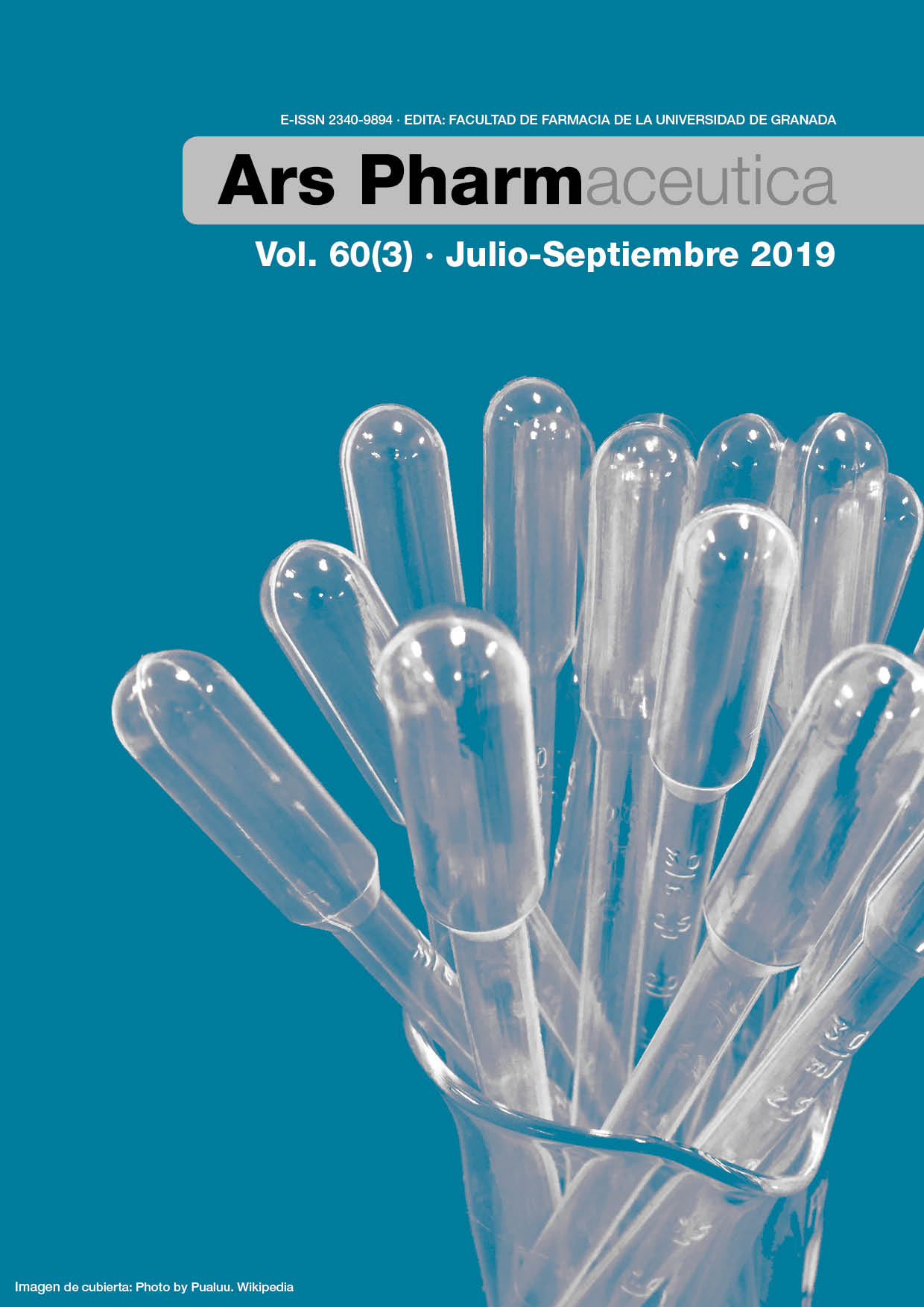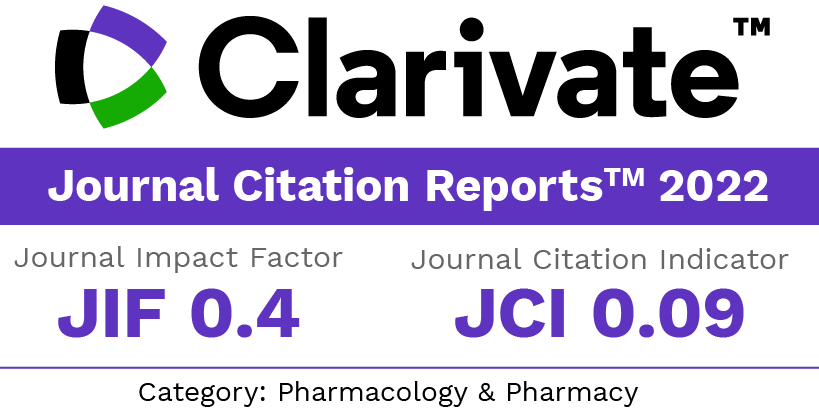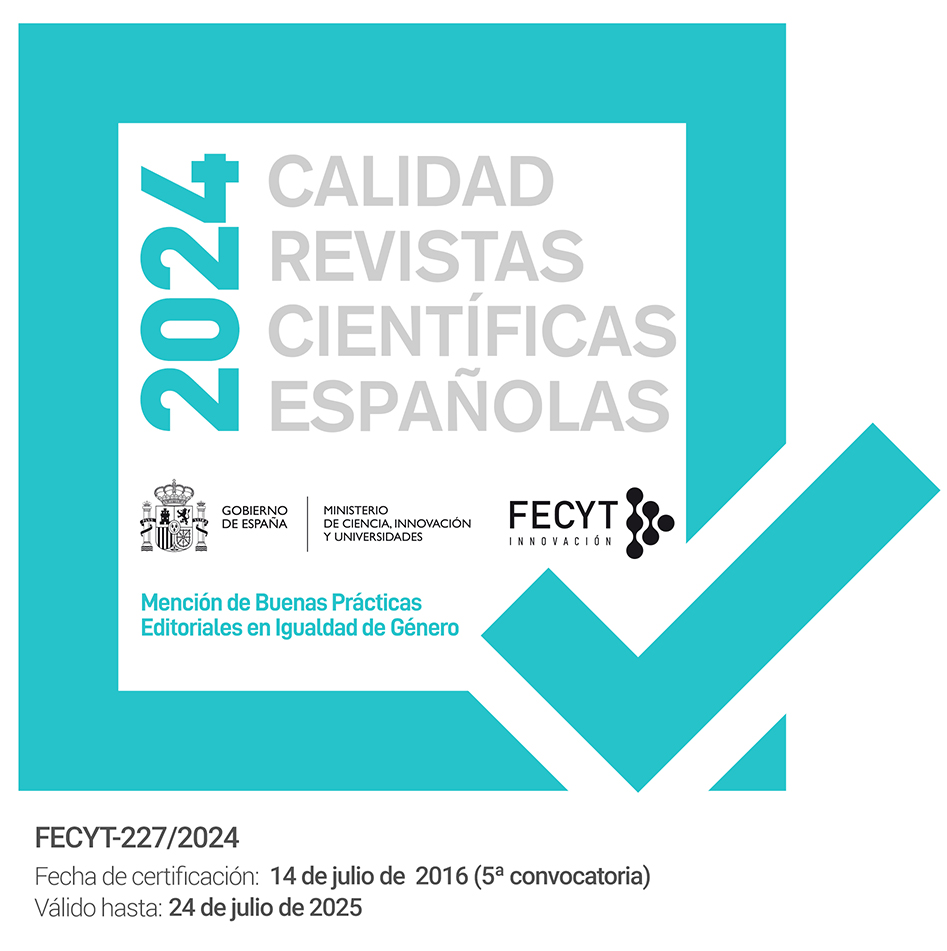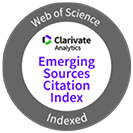Liposomal delivery of 5 Fluorouracil and Tretinoin: An Aspect of Topical treatment of skin warts
DOI:
https://doi.org/10.30827/ars.v60i3.7966Keywords:
5-fluorouracil, Tretinoin, Liposomes, in vitro drug release, 32 experimental designAbstract
Background: Tretinoin and 5-fluorouracil are indicated for treatment of various skin disorders and actinic keratosis respectively.
Objective: Present study was focused to design liposomes containing 5- fluorouracil and tretinoin. Design was further optimized by 32 full factorial design.
Methods: Liposomes were prepared by ethanol injection method and evaluated by Transmission Electron Microscopy, percentage entrapment efficiency, zeta potential and in vitro drug release. Optimized formulation was subjected to histopathological and stability studies at 4ºC, 25ºC and 60ºC temperatures.
Results: No drug crystals were visible in transmission electron microscopy, regardless of the preparation technique or the loaded drug. Formulation F9 showed maximum drug entrapment of 72.86% and 69.70% for 5-fluorouraciland tretinoin respectively. When phospholipid concentration was increased from 40 to 60 mg/ml, encapsulation efficiencies of formulation increased. Zeta potential and particle size were maintained within range of -19.14 to -25.61 and 100 to 200 nm respectively which facilitated good stability and penetration of liposomes. Dissolution profiles of formulations F1 to F6 showed high amount of drug release (30.6 to 67.42%) at 2 h. Liposomes were not stable at high temperature but formulations were most stable when stored at lower temperature i.e. 4oC.
Conclusion: So, in liposomes both 5-fluorouracil and tretinoin were successfully incorporated and it can be further used for formulation development.
Downloads
References
Akhtar N. Vesicles: A Recently Developed Novel Carrier for Enhanced Topical Drug Delivery. Current Drug Del. 2014:11:87-97. DOI : 10.2174/15672018113106660064
Nguyen TL, Nguyen TH and Nguyen DH. Development and In Vitro Evaluation of Liposomes Using Soy Lecithin to Encapsulate Paclitaxel. Int J Biomat. 2017:7. DOI:10.1155/2017/8234712
Yadav D, Sandeep K, Pandey D and Dutta RK. Liposomes for Drug Delivery. J Biotechnol Biomater. 2017;7:276. DOI: 10.4172/2155-952X.1000276
Tiwari R, Tiwari G, Wal P, Wal A and Gupta C. Treatment of warts by topical Retinoids: An Exploration and Meticulosity. Pharma Times.2018;9:9-12.
Akhtar N, Pathak K. Cavamax W7 Composite Ethosomal Gel of Clotrimazole for Improved Topical Delivery: Development and Comparison with Ethosomal Gel. AAPS pharm Sci Tech., 2012; 13(1): 344-355. DOI: 10.1208/s12249-012-9754-y
Cevc G. Phospholipids Handbook, Marcel Dekker, New York, 1992.
Egbaria K and Weiner N. Liposomes as a topical drug delivery system. Advanced Drug Delivery Reviews. 1990;5:287-300. DOI:10.1016/0169-409X(90)90021-J
Prabhakar P, Samip Sand Shankar G. Formulation development and investigation of domperidone transdermal patches. Int J Pharm Investig. 2011;1:240–246. DOI: 10.4103/2230-973X.93008
Acharya A, Dhakal P and Khadka D. Formulation and Evaluation of Transdermal Gel of Lornoxicam and its Delivery by Passive and Inotophoresis Method: A Comparative Study. Int J Pharm Sci Res. 2016;7:810-18. DOI: 10.13040/IJPSR.0975-8232
Epstein H, Gutman D, Cohen-Sela E, Haber E, Elmalak O, Koroukhov N. Preparation of alendronate liposomes for enhanced stability and bioactivity: in vitro and in vivo characterization. AAPS J.2008;10:505–515. DOI: 10.1208/s12248-008-9060-5
Mayer LD, Bally MB, Hope MJ, Cullis PR. Techniques for encapsulating bioactive agents in to liposomes. Chem Phys Lipids.1986;40:333–345.DOI:10.1016/0009-3084(86)90077-0
Tiwari R, Tiwari G, Wal P, Wal A and Maurya P. Understanding the Impact of Polymer Ratio and its Concentration on Omeprazole Release from Matrix Tablets: Response Optimization Study. Int J Drug Del Tech.2017;713-21.
Batzri S and Korn ED. Single bilayer liposomes prepared without sonication. BiochimBiophysActa.1973;16:1015-9. DOI:10.1016/0005-2736(73)90408-2
Tiwari R, Tiwari G, Wal P, Wal A and Maurya P. Development, Characterization and Transdermal Delivery of Dapsone and an Antibiotic Entrapped in Ethanolic Liposomal Gel for the Treatment of Lapromatous Leprosy. The Open Nanomed J.2018;51-15. DOI: 10.2174/1875933501805010001
Fang JY, Hong CT, Chiu WT, Wang YY. Effect of liposomes and niosomes on skin permeation of enoxacin. Int J Pharm. 2001;219:61–72. DOI:10.1016/S0378-5173(01)00627-5
Hitzman CJ, Elmquist WF, Wattenberg LW, Wiedmann TS. Development of a respirable, sustained release microcarrier for 5- FU: in vitro assessment of liposomes, microspheres, and lipid coated nanoparticles. J Pharm Sci. 2006;95:1114–1126. DOI:10.1002/jps.20591
Juliano RL, Stamp D, McCullogh N. Pharmacokinetics of liposomes encapsulated antitumor drugs and implications for therapy. Ann N Y Acad Sci. 1998;308:411–423. DOI:10.1111/j.1749-6632.1978.tb22038.x
Kesisoglou F, Zhou SY, Niemiec S, Lee JW, Zimmermann EM, Fleisher D. Liposomal formulations of inflammatory bowel disease drugs: local versus systemic drug delivery in a rat model. Pharm Res. 2005;22:1320–1330. DOI:10.1007/s11095-005-5376-3
Ali DS, Fatih H, Erdal C, Zeki O, Ahmet LB and Jülide A. Chitosan film containing fucoidan as a wound dressing for dermal burn healing: Preparation and in vitro/in vivo evaluation. AAPS Pharm Sci Tech.2007;8:E94–E101. DOI: 10.1208/pt0802039
Chiranjeevi C, Muthukumaran M, Krishnamoorthy B. A review on potency of vesicular systems in targeting drug delivery. Res. J. Pharm. Bio. Chem. Sci. 2013;4:156-170.
Gregoriadis G, Davis C. Stability of liposomes in vivo and in vitro is promoted by their cholesterol content and the presence of blood cells. Biochem Bioph Res Co.1979;89:1287–1293. DOI:10.1016/0006-291X(79)92148-X
Published
How to Cite
Issue
Section
License
Copyright (c) 2019 Ruchi Tiwari, Gaurav Tiwari, Ankita Wal, Chitranshu Gupta

This work is licensed under a Creative Commons Attribution-NonCommercial-ShareAlike 4.0 International License.
The articles, which are published in this journal, are subject to the following terms in relation to the rights of patrimonial or exploitation:
- The authors will keep their copyright and guarantee to the journal the right of first publication of their work, which will be distributed with a Creative Commons BY-NC-SA 4.0 license that allows third parties to reuse the work whenever its author, quote the original source and do not make commercial use of it.
b. The authors may adopt other non-exclusive licensing agreements for the distribution of the published version of the work (e.g., deposit it in an institutional telematic file or publish it in a monographic volume) provided that the original source of its publication is indicated.
c. Authors are allowed and advised to disseminate their work through the Internet (e.g. in institutional repositories or on their website) before and during the submission process, which can produce interesting exchanges and increase citations of the published work. (See The effect of open access).























